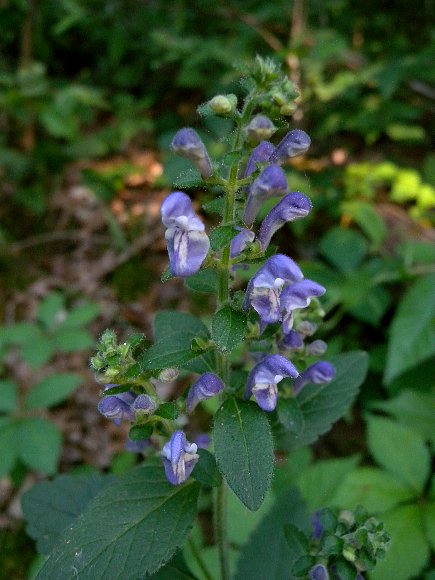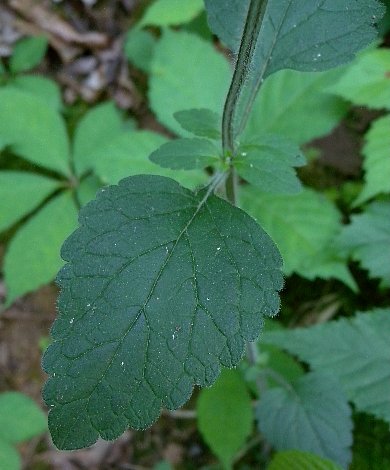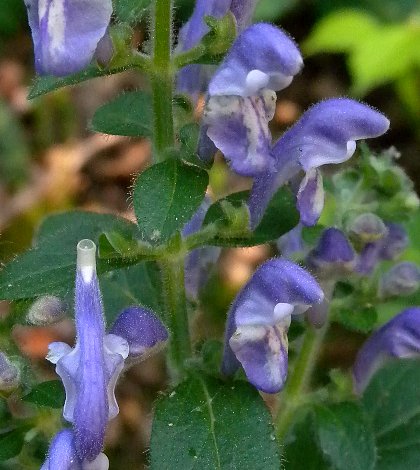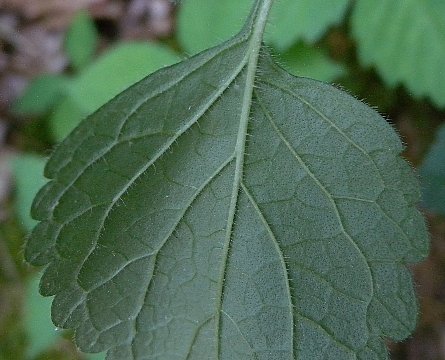
The central stem terminates in a spike-like raceme of flowers up to 4" long. In addition to this raceme, secondary racemes are sometimes produced from the axils of the upper leaves. The central stalk of each raceme is 4-angled, green to purplish green, and glandular-hairy; the hairs are widely spreading. Individual flowers along the raceme are ½-¾" long; their 2-lipped corollas are strongly ascending, but their mouths open laterally. Each flower consists of a pale to dark blue-violet corolla, a short green calyx, 4 inserted stamens, and a 4-lobed ovary with a single style. The corolla has a hood-like upper lip and a descending lower lip; the back and apex of the hood are more or less finely pubescent. The lower lip has irregular blotches of white (usually in pairs along the sides of a central blue-violet vein). In addition to these lips, there are also a pair of small lateral lobes. The lateral lobes are attached to the upper lip; they are often whitish and recurved. The calyx is glandular-hairy and shallowly divided into two lobes; there is a conspicuous protuberance on the back of the calyx.

The pedicels of the flowers are short (about 4 mm. in length), relatively stout, and pubescent. At the pedicel bases, there are pubescent leafy bracts up to 1¼" long and ½" across; they are lanceolate-oblong or elliptic-oblong in shape. The margins of these leafy bracts are ciliate and either toothless (entire) or sparingly crenate-serrate. The blooming period occurs from late spring to mid-summer, lasting about 3-4 weeks. Afterwards, the corollas become detached and wither away, while the persistent calyces become swollen and enclose the developing nutlets. There are 1-4 nutlets per calyx (often only 1 or 2). The small nutlets are minutely tuberculate. The calyces eventually split open to eject the nutlets; this may be caused in part by raindrop logistics. The root system is fibrous and short-rhizomatous.
Cultivation: The preference is light shade to partial sun, mesic to dry-mesic conditions, and an acidic soil containing some organic material.

Range & Habitat: The native Hairy Skullcap is occasional in southern Illinois, while in the rest of the state it is largely absent (see Distribution Map). Illinois lies along the northern range-limit of this species. However, a northern outlier population occurs in SE Michigan and NW Indiana. Habitats include rocky woodlands, bluffs, wooded slopes, rocky areas along streams, and well-drained bottoms of sandstone canyons. Hairy Skullcap is found in higher quality natural areas. In some areas of southern Illinois, it is currently threatened by the spread of an invasive species, Japanese Stilt Grass (Microstegium vimineum).
Faunal Associations: The nectar and pollen of the flowers attract various bees. Butterflies and skippers may also visit the flowers, but they are less effective at cross-pollination. The leaves of Hairy Skullcap and other Scutellaria spp. (Skullcaps) are attacked by several skeletonizing leaf beetles (Phyllobrotica spp.) and the Shining Flea Beetle (Asphaera lustrans). In particular, Phyllobrotica circumdata has been observed on Hairy Skullcap. The larvae of two micro-moths also feed on the foliage of Scutellaria spp. (Skullcaps): Caloptilia scutellariella and Prochoreutis inflatella. Larvae of the former moth are blotch leaf-miners, while larvae of the latter moth skeletonize the leaves. The bitter foliage is not eaten by mammalian herbivores.

Photographic Location: A wooded sandstone canyon in southern Illinois.
Comments: This is another native species of Scutellaria (Skullcap) that could be cultivated in shaded gardens. Both the foliage and flowers are reasonably attractive. The bitter foliage does not have a mint fragrance. It is possible to confuse Hairy Skullcap (Scutellaria elliptica) with some of the other woodland Scutellaria spp. in Illinois. It differs from Heart-Leaved Skullcap (Scutellaria ovata) by having less wide leaves that lack cordate bases (with the possible exception of the lowermost leaves). It also differs from Downy Skullcap (Scutellaria incana) by having spreading glandular hairs on its stems, flowering stalks, and calyces. The foliage and calyces of Downy Skullcap are more short-pubescent or canescent and they lack glandular hairs. Another woodland species, Showy Skullcap (Scutellaria serrata), has glabrous foliage and larger flowers (1" in length or more). Across its range, Hairy Skullcap varies somewhat in the extent of its hairiness: the typical variety is less hairy than var. hirsuta.